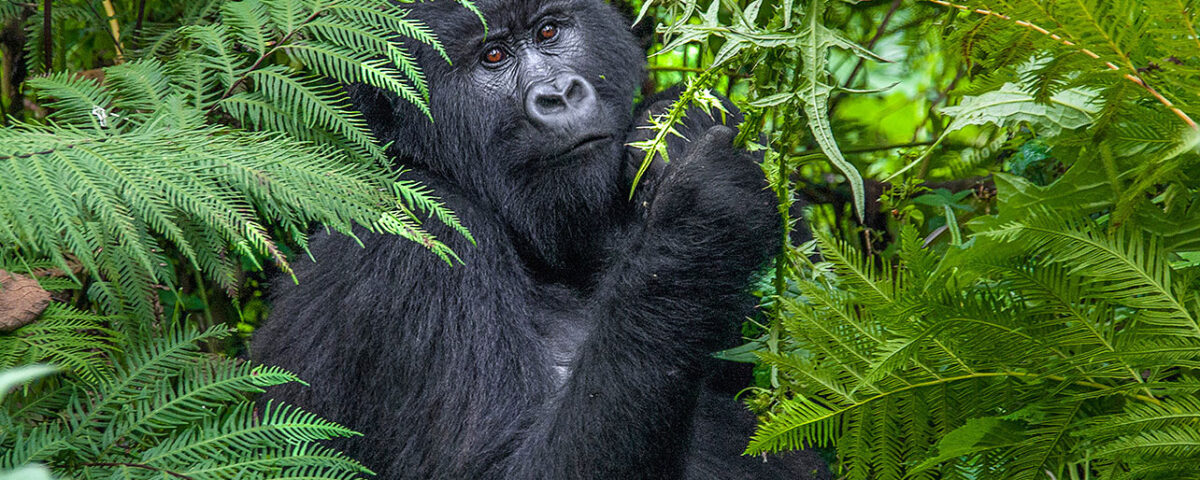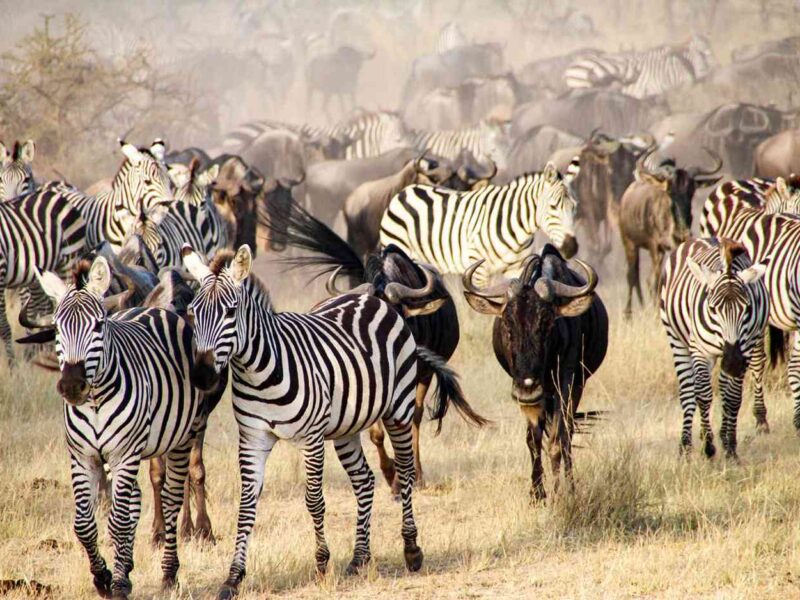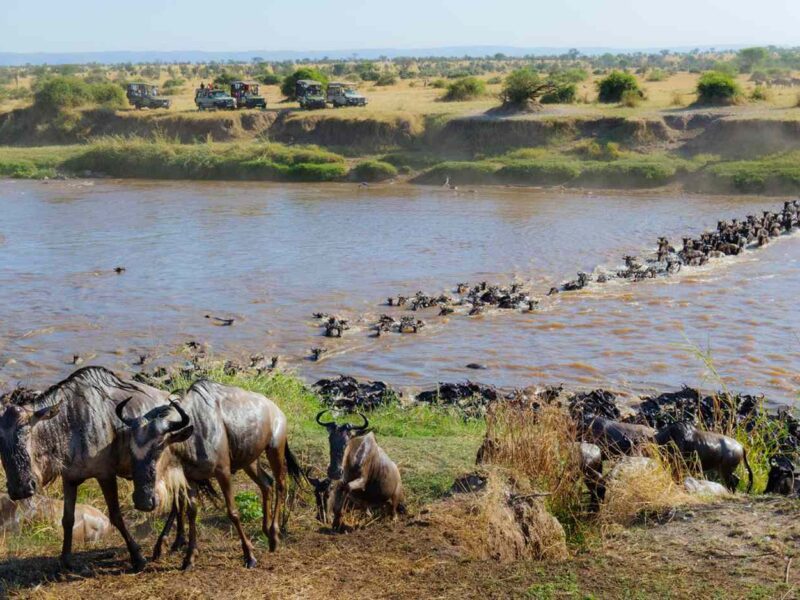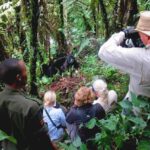
Where is the Best Place to Go Gorilla Trekking?
March 27, 2025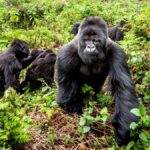
How Do I Book Gorilla Trekking?
March 28, 2025What Food Do Gorillas Eat?.
Gorillas, our closest living relatives in the animal kingdom, are fascinating creatures with intricate and varied dietary habits. As predominantly herbivores, their diet consists of a wide range of plant materials, which are vital for their survival, health, and energy. Understanding what gorillas eat provides insight not only into their behavior and ecology but also into the conservation efforts necessary to protect their habitats. At Ovacado Adventures Ltd., we are committed to educating travelers and wildlife enthusiasts about these magnificent animals, and we believe that understanding their food preferences is key to ensuring their continued survival. In this article, we delve into the foods that gorillas consume, their feeding behavior, and the ecological importance of their diet.
The Herbivorous Diet of Gorillas
Gorillas are classified as herbivores, meaning their diet consists mostly of plant material. Although they share more than 98% of their DNA with humans, their dietary needs are quite different. Gorillas have evolved to primarily consume plant-based food, which is abundant in the forests and jungles of Central and East Africa, where they are predominantly found. Their diet is rich in fiber, vitamins, and minerals, which are essential for maintaining their energy, muscle mass, and overall health.
There are two main species of gorillas: the Eastern gorilla (which includes the Mountain gorilla) and the Western gorilla. While their diets are similar, subtle differences exist based on their habitats and the plant species available in each region. Both species primarily consume vegetation such as leaves, stems, fruits, and flowers, with a small proportion of their diet occasionally consisting of insects.
Key Components of a Gorilla’s Diet
Gorillas are highly selective in their feeding habits, often choosing the most nutritious and tender parts of plants. Their diet consists of several key components, each contributing to their overall health and nutritional needs.
Fruits
Fruits are one of the most enjoyable food sources for gorillas and are a major part of their diet, especially during certain times of the year. Gorillas consume a wide variety of fruits, including bananas, papayas, figs, berries, and more. Fruits are rich in sugars and vitamins, which provide gorillas with the energy required for their daily activities, including foraging and socializing.
The high water content of fruits also helps with hydration, which is essential, especially in the humid environments of tropical forests where gorillas live. However, gorillas tend to be selective eaters and prefer fruits that are ripe and sweet, leaving behind those that are unripe or sour.
Leaves and Stems
A significant portion of a gorilla’s diet is made up of leaves, which are easily accessible in their forested habitats. Gorillas are known to consume the leaves of various plants, trees, and shrubs. They prefer young, tender leaves, which are packed with essential vitamins, minerals, and antioxidants.
In addition to leaves, stems form an important part of their diet. Gorillas are particularly fond of the tender shoots and stems of plants such as bamboo, wild celery, and other herbaceous vegetation. The stems provide an excellent source of fiber, which aids in digestion and helps gorillas maintain their strong muscles and overall health.
Bark and Roots
When fruits and tender leaves are less available, particularly during the dry season, gorillas turn to more fibrous food sources such as bark and roots. Gorillas have strong jaws and teeth that allow them to chew through the tough bark of trees. This part of their diet is important as it provides a source of minerals, especially calcium, which is crucial for bone health.
Roots are another important food source, with gorillas consuming the underground parts of certain plants like wild ginger. These roots provide additional nutrients and carbohydrates that help gorillas maintain their energy levels, especially during periods of scarcity in other food sources.
Flowers
While not a staple of their diet, flowers are occasionally consumed by gorillas. Flowers are rich in vitamins and minerals, particularly calcium and iron, which help with the gorillas’ bone and muscle health. Gorillas may consume flowers when they are in season and when they are readily available. Some species of flowers are also known to provide small amounts of protein, which is beneficial for muscle growth and repair.
Insects
Though they are primarily herbivores, gorillas are known to occasionally consume insects. Small insects, such as ants and termites, are eaten for their protein content and other essential nutrients. Insects represent a small portion of the gorilla’s diet, but their consumption is an example of how gorillas can adapt to the availability of food in their environment.
Gorillas often forage for insects by breaking open ant nests or termite mounds with their hands. This behavior is an interesting aspect of their diet, showing their ability to utilize multiple food sources to meet their nutritional needs.
Foraging Behavior and Social Dynamics
Gorillas spend a significant amount of time each day foraging for food. Their foraging behavior is shaped by their environment, social structure, and the availability of resources. Gorillas are known to be diurnal creatures, meaning they are most active during the day, spending several hours foraging and eating.
Foraging Strategies
Gorillas travel across their home range, which can span several kilometers, in search of food. Their diet varies depending on the season, with gorillas eating more fruit during the rainy season when it is more abundant, and more fibrous plants such as bamboo and roots during the dry season when fruits are less available. Gorillas are skilled foragers, using their strong hands and teeth to grasp and break apart vegetation.
Their feeding habits also vary based on the social structure of the group. The dominant male, known as the silverback, plays a key role in leading the group to the best foraging areas. The silverback ensures that the group has access to food, guiding them to areas where resources are plentiful.
Group Feeding Behavior
Gorillas are social animals, and their feeding behavior is influenced by group dynamics. They often feed together, strengthening social bonds within the group. While the silverback leads the group, other members, including females and young gorillas, forage together, with some staying closer to one another while others venture farther afield.
Despite their occasional competitive behavior for prime food sources, gorillas are generally cooperative during feeding sessions, as social eating fosters a sense of security and strengthens group cohesion.
The Importance of Gorillas’ Diet to Their Health and Conservation
A gorilla’s diet is essential for maintaining its large, muscular body and supporting its overall health. Gorillas require a wide range of nutrients, including fiber, vitamins, and minerals, which they derive from the diverse plants they consume. Their digestive systems are specially adapted to handle fibrous plant material, allowing them to extract maximum nutrition from their food.
However, the availability of these food sources is under threat due to habitat destruction, deforestation, and human encroachment. As gorillas’ natural habitats shrink, the resources they rely on for sustenance become scarcer. At Ovacado Adventures Ltd., we believe that preserving gorilla habitats and ensuring the sustainability of their food sources is critical for their long-term survival.
Conclusion
Gorillas are primarily herbivores with a varied and selective diet that includes fruits, leaves, stems, flowers, bark, and even insects. Their feeding behavior is shaped by seasonal changes and the availability of resources, and their diet is essential for maintaining their health, strength, and social cohesion. Understanding what gorillas eat not only helps us appreciate their ecological role but also underscores the importance of conservation efforts aimed at protecting their habitats and ensuring a sustainable future for these magnificent creatures. At Ovacado Adventures Ltd., we are dedicated to promoting responsible wildlife tourism and supporting conservation initiatives that safeguard the future of gorillas and their ecosystems.


